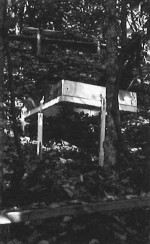Participating on the Long-Term Intersite Decomposition Experiment Team (LIDET) project has allowed me to gain valuable experience in a network-wide intercomparison study as a graduate student. Most people are familiar with the LIDET project as a bold cross-site field study. At 17 sites in the LTER Network (and several other sites), decomposition rates of 10 types of plant litter (most foreign to the site) are being monitored in the field. But there is also a modeling component.
As part of my dissertation work, I (together with advisor John Aber) have developed a model to predict field results across a range of sites. Not only is the LIDET data collected in a coordinated fashion, but the modeling project itself involves an intercomparison study in which three other models run by LTER investigators (Daryl Moorhead, Jornada; Bill Parton, Central Plains; Ed Rastetter, Arctic Tundra) are making equivalent predictions. Mark Harmon, H.J. Andrews, is project coordinator.
The experience of collaborating with established researchers in the Network has been invaluable. I would recommend it to any student based on this reason alone. People at different sites are apt to use different techniques, cite different references, use different units, and so on. Learning to speak the various languages has been as much a part of this project as learning about the ecology of other sites.
The greatest difficulty in the project has been in achieving a degree of standardization among the models so that differences in predictions could be traced to the appropriate causes. It was probably easier for me, as a student, to mold my model to the needs of the project because the model was still in development. Some intersite work might actually even be easier for students than for investigators, who have much invested in certain techniques or methods.
Another facet of the intersite work worth mentioning is its pace. It is much easier to work slowly on a project in which you only communicate with collaborators every couple of months via e-mail, than it is to work slowly on a project in which you pass your collaborators in the hall every day! Intercomparison work proceeds, at each step, at the pace of the slowest participant at that time. Since a project may run a long time from inception to completion a student may not want to stake his or her “graduating” schedule on an intersite collaboration. On the other hand, students may also consider such work an investment in the future. As I search now for a post-doctoral position, my involvement in the LIDET project is paying dividends, because I know much more about other LTER sites and I already have working relationships with some of the scientists.

 Enlarge this image
Enlarge this image